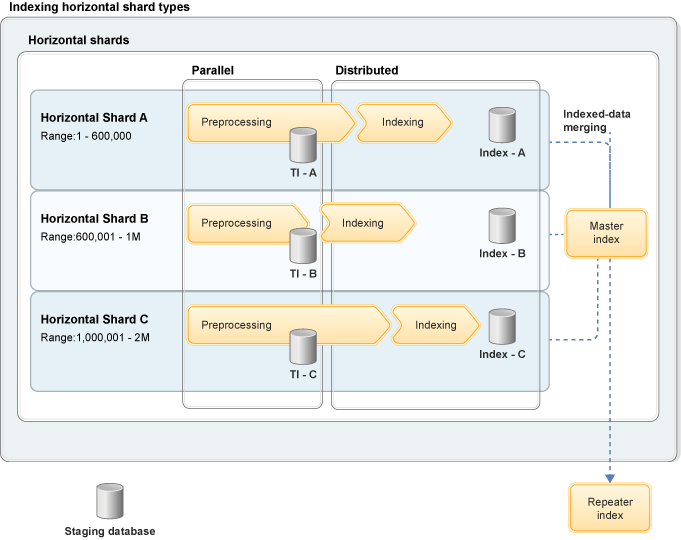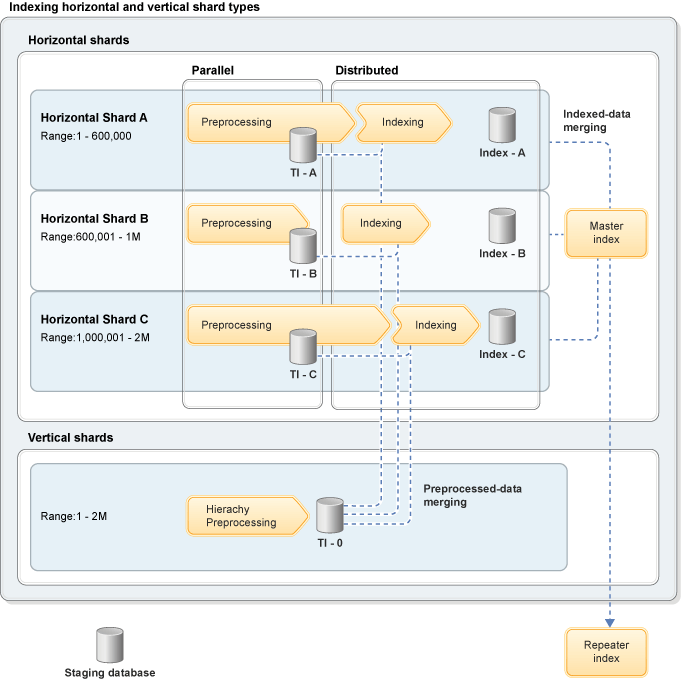Parallel preprocessing and distributed indexing
You can index large catalog data into the search server with parallel preprocessing and distributed indexing by sharding and merging.
Data can be split either horizontally or vertically into different threads, so that each thread can process smaller chunks of the data. This approach is useful when the catalog size is large, or when preprocessing and indexing times are not acceptable. After the data is processed, it is merged into a single master data set. Depending on if the data was split horizontally or vertically, the merging of the data occurs in different levels. The number of shards or the size of the data each shard contains typically depends on available software and hardware resources.
Shards can be created using the setup search index utility (setupSearchIndex). Parameters are passed in to decide the number and type of shards. Then, the shard indexing utility (di-parallel-process) is used to perform the parallel preprocessing and indexing.
- Sharding does not replace the existing preprocessing and indexing utilities. Instead, it is used as a fast path for indexing catalog entry data.
- The shard indexing utility (di-parallel-process) can set up and build structured and unstructured catalog entry indexes. However, all other index types are built using the existing preprocessing and indexing utilities.
- Sharding supports only full index builds. Sharding is not required for delta updates because they do not typically perform poorly.
- Sharding is used only for changes to approved content. It is not used for changes to workspaces.
- Contract price data is not supported by the shard indexing utility.
- This approach is not supported by a Derby database.
The following sections define the shard types and processes that are performed for each type, including indexing approaches.
Shard types
Horizontal and vertical shard types can be created by the setupSearchIndex utility.
Horizontal shards
Horizontal shards process a predefined number of catalog entries independently of the other horizontal shards. It processes multiple catalog entry properties at the same time.
- Horizontal shards preprocess the catalog entry data into its own temporary tables.
- The preprocessed data is indexed into a separate index core.
- The indexed data is then later merged into a final master index.
After processing horizontal shards, the final data format that is produced is indexed data.
Vertical shards
Vertical shards process only one property of all the catalog entries. That is, only one operation is performed in vertical shards: Preprocessing the data into a temporary table.
Due to Solr indexing requirements, the entire Solr index document's fields must be available when the document is created. Therefore, vertical indexing is not supported by default.
After processing vertical shards, the final data format that is produced is preprocessed data.
Shard indexing approaches
- Indexing only horizontal shard types, or
- Indexing a combination of horizontal and vertical shard types.
Indexing only horizontal shard types
Indexing only horizontal shard types results in all of the shards preprocessing at the same start time. They are run in parallel, independently of each other. After any of the shards completes preprocessing, it can immediately start indexing its preprocessed data into its own index core.
After all shards are indexed, an index merge command is triggered to merge all shard indexes into a single master index. Since all horizontal shards produce indexed data, the resulting merge works with indexed data for the master index.

- Shards, A, B, and C process different range sizes.
- All shards start preprocessing at the same time.
- Each of the shards writes into its own temporary tables. Due to the different range values, each preprocess completes at different time.
- Indexing of each shard starts immediately after its preprocessing task completes. Therefore, the indexing starts and ends at different times.
- After all the shards complete their indexing, a merge command is sent to merge the three different shards indexed data into the master index. Then, the data is replicated into the repeater index.
Indexing horizontal and vertical shard types
Indexing a mix of horizontal and vertical shards type is slightly different from indexing horizontal shards only. While the preprocessing of all shards can start at the same time, the horizontal shards indexing can begin only after all the vertical shards complete their preprocessing. The horizontal shards indexing scripts read data from both its own shard's temporary table, and the vertical shard's temporary table.

- All shards' preprocessing tasks begin at the same time.
- Horizontal shard B completes its preprocessing task, however remains idle until the vertical shard preprocessing completes. After the vertical shard preprocessing completes, the indexing can begin.
- The vertical shard has only a preprocess task, results in preprocessed data to be merged by the horizontal shards, in addition to their own preprocessed data.
- After the indexing tasks are complete, a merge command is sent to merge the horizontal shard's indexed data into the master index, then replicated into the repeater index.
By default, the catalog hierarchy is only supported for a vertical shard. However, you can create custom vertical shards to suit your requirements.
- If any of the temporary tables in the identified preprocessing XML file take longer to preprocess than other tables
- If no other temporary tables depend on the identified XML file's temporary tables
- If none of the temporary tables in the identified preprocessing XML file join with the particular shard table (TI_CATENTRY_0_#SHARD_TAG#)
If any of these conditions are true, then it can be moved into its own shard and removed from each of the individual shards. For example, the wc-dataimport-preprocess-parent-catgroup.xml file calculates indirect parent categories that a catalog entry has.